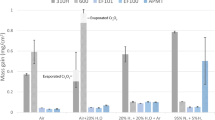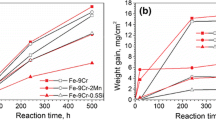Abstract
The early stages of corrosion of AISI 314, HK 40, and Alloy 800H have been studied in a strongly carburizing (aC=0.8), weakly oxidizing\((P_{O_2 } = 10^{ - 30} bar)\) atmosphere at 1098 K. Samples with electropolished and cold-worked surfaces were exposed for up to 400 min. at temperature, in a conventional corrosion rig or in a reaction vessel which was installed within an X-ray photoelectron spectrometer. The latter facility allowed the effects of the specimen heating rate and the rat of gas flow to be investigated. Examination of the corrosion products was accomplished with the aid of XPS, SEM, TEM, and conventional metallography. Initially, surface layers comprised of α-Cr2O3, (Mn, Cr)3O4, and SiO2 formed, with layer structure, microstructure, and composition being functions of alloy composition and surface condition. Only on the cold-worked surfaces did a well-developed duplex oxide, consisting of an outer, Cr-rich oxide layer and an inner, SiO2 layer, form. In good agreement with the predicted value of 1.9 wt.%, between 1.4 and 2 wt.% Si in the alloy was required to form a complete SiO2 layer. After an incubation period, α-Cr2O3 became unstable and transformed to M7C3; the carbides then grew by diffusion of metal from the alloy substrate. The presence of manganese, as (Mn, Cr)3O4, in the surface oxide influenced the mode of carbide growth, whereas the rate of carbide growth was severely suppressed by a continuous SiO2 layer which acted as a diffusion barrier both to metal and to carbon. It is argued that the SiO2 layer is most effective in reducing carburization when it is free from or contains very few structural defects.
Similar content being viewed by others
References
R. H. Kane,Cor. 37, 187 (1981).
O. Van der Biest, J. M. Harrison, and J. F. Norton,Proc. Int. Conf. Behaviour of High Temperature Alloys in Aggressive Environments (The Metals Society, Bristol, U.K., 1980), p. 681.
M. J. Graham, G. I. Sproule, D. Caplan, and M. Cohen,J. Electrochem. Soc. 119, 883 (1972).
M. G. C. Cox, B. McEnaney, and V. D. Scott,Philos. Mag. 29, 585 (1974).
C. P. Jensen, D. F. Mitchell, and M. J. Graham,Corr. Sci. 22, 1125 (1982).
P. J. Smith, O. Van der Biest, and J. Corish,Oxid. Metals, in press.
J. M. Harrison, J. F. Norton, R. T. Derricott, and J. B. Marriott,Werkst. Korr. 30, 785 (1979).
G. C. Wood, J. A. Richardson, M. G. Hobby, and J. Boustead,Corr. Sci. 9, 659 (1969).
J. Beech and D. H. Warrington,J. Iron Steel Inst. 204, 460 (1966).
J. J. Barnes, O. Van der Biest, J. F. Norton, P. J. Smith, and J. Corish, to be published.
A. Atkinson,Corr. Sci. 22, 87 (1982).
W. Frank, H. J. Engell, and A. Seeger,Trans. Met. Soc. AIME 242, 749 (1968).
I. Barin and O. Knacke,Thermochemical Properties of Inorganic Substances (Springer Verlag, New York, 1973).
E. W. Hart,Acta. Met. 5, 597 (1954).
N. N. Khoi, W. W. Smeltzer, and J. D. Embury,J. Electrochem. Soc. 122, 1495 (1975).
M. G. C. Cox, B. McEnaney, and V. D. Scott,Philos. Mag. 26, 839 (1972).
I. G. Crouch and J. C. Scully,Oxid. Metals 15, 101 (1981).
A. Atkinson and J. W. Gardner,Corr. Sci. 21, 49 (1981).
T. Ban, T. Bohnenkemp and H. J. Engell,Corr. Sci. 19, 283 (1979).
Author information
Authors and Affiliations
Rights and permissions
About this article
Cite this article
Smith, P.J., Van der Biest, O. & Corish, J. Initial stages of the high-temperature corrosion of commercial Fe-Cr-Ni alloys in a carburizing atmosphere of low oxygen partial pressure. Oxid Met 24, 277–314 (1985). https://doi.org/10.1007/BF00657062
Received:
Issue Date:
DOI: https://doi.org/10.1007/BF00657062




